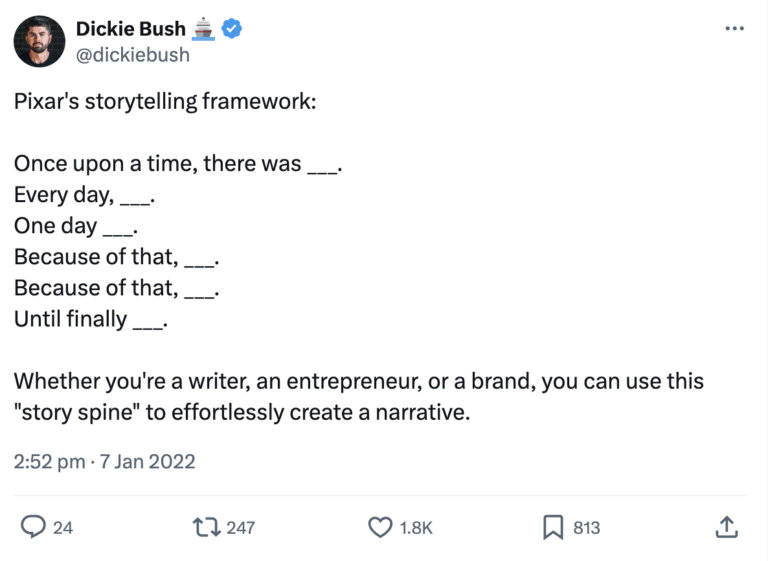Frameworks Tweet Template
Use this Tweet template to describe a structured approach to a topic, outlining steps from the initial condition to the final outcome, useful for analysis in diverse roles or fields.
Why this Tweet Template works
This framework is effective in marketing and on social media for several reasons:
1. It outlines a clear, step-by-step process that is easy for the audience to follow, which helps in simplifying complex topics or scenarios. This structured approach makes the content more digestible and engaging.
2. By leading the audience through a series of developments from a starting condition to a final outcome, the story creates a compelling and relatable narrative. This storytelling aspect can significantly increase engagement and retention of the information presented.
The Blank Tweet Template
[Company or Entity’s] [Topic] framework:
1. [Starting Condition or State].
2. [Consistent State or Routine].
3. [Change or Event].
4. [First Consequence or Development].
5. [Second Consequence or Development].
6. [Final Outcome or Resolution].
This approach can be utilized by individuals in various roles or fields to systematically address or analyze [Topic or Scenario].
How to use this Twitter Tweet Template
Evaluate How the Template Fits Your Content Goals and Needs
To effectively use the “”[Company or Entity’s] [Topic] framework”” template, start by assessing how it aligns with your content goals. Whether you’re aiming to establish authority, drive engagement, or foster community growth, this structured approach can help articulate complex processes or transformations in your field. For instance, if your goal is to highlight expertise in a specific area, using this framework to break down a complicated process into understandable steps can position you as a thought leader.
Audience Awareness Within the Context of the Buyer’s Journe
Understanding where your audience stands in the Buyer’s Journe is critical. This template is versatile and can be adapted to different stages:
– For those at the problem aware stage, focus on the “”Starting Condition or State”” to resonate with their current challenges.
– When targeting the solution aware audience, emphasize the “”Change or Event”” to showcase potential solutions.
– For the product aware group, the “”Final Outcome or Resolution”” can be highlighted to demonstrate the effectiveness of your product or service.
Tailoring the content to these stages ensures relevance and engagement.
Personalization
Personalizing the template involves more than just filling in the blanks with your specific topic or scenario. It requires adapting the language, examples, and case studies to match your audience’s interests, industry jargon, and cultural touchpoints. This might mean using industry-specific examples in the “”Consistent State or Routine”” or incorporating user-generated content as part of the “”Change or Event”” to increase relatability and engagement.
Modern Trends
Incorporating modern trends into your content can significantly enhance its appeal and relevance. This could involve linking the “”Change or Event”” to emerging industry innovations or societal shifts. Additionally, leveraging multimedia elements like infographics or short videos to illustrate the “”First Consequence or Development”” and “”Second Consequence or Development”” can align with contemporary content consumption preferences, making your message more engaging and shareable.
Call to Action (CTA)
A clear CTA is essential for guiding your audience towards the next step. Depending on your content goals and the audience’s stage in the Buyer’s Journe, your CTA could range from inviting comments and sharing, to directing viewers to a landing page for more in-depth information. Ensure the CTA is directly related to the “”Final Outcome or Resolution,”” making it a natural next step for the audience to take after engaging with your content.


